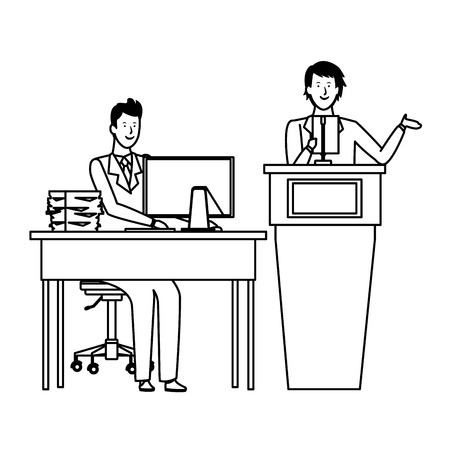1. Understanding the Structure of a Panel Interview
When you’re preparing for a panel interview in the US, it’s important to know what to expect. Unlike a traditional one-on-one interview, a panel interview involves being interviewed by multiple people at the same time. This format is common in American companies, especially for roles that require cross-functional teamwork or leadership skills.
Who Is on the Panel?
Usually, a panel will include representatives from different departments who have a stake in the hiring decision. Here’s an example of what a typical panel might look like:
| Panel Member | Role in Interview |
|---|---|
| Hiring Manager | Assesses your technical skills and fit for the role |
| HR Representative | Evaluates your cultural fit and understanding of company policies |
| Potential Teammate | Looks at how well you’d work with the team |
| Department Leader | Considers your potential impact on department goals |
What Are Their Roles?
Each person on the panel brings their own perspective. The hiring manager focuses on your experience and job-specific abilities. The HR representative wants to make sure you match the company’s values and can handle its processes. A teammate may ask about collaboration or conflict resolution, while a department leader could be interested in how your skills support larger business objectives.
Key Points to Remember:
- You may face questions from several people at once.
- Each interviewer will likely focus on different areas, so be ready to address various topics.
- Their goal is to see how you think on your feet and interact with diverse personalities.
This unique structure means it’s essential to engage with everyone on the panel, making eye contact and addressing answers to all members, not just one person. Knowing who’s likely to be there—and what matters most to each—can help you tailor your responses and make a great impression from the start.
2. Researching the Company and Its Culture
Before stepping into a panel interview in the US, it’s important to show that you’ve done your homework about both the company and its unique workplace culture. American employers value candidates who not only understand what the company does but also align with its values, work style, and expectations. Here’s how you can get started:
Why Company and Culture Research Matters
Panel interviews often include questions that test your knowledge of the organization and assess if you’ll fit into their team. When you can speak confidently about the companys mission, recent achievements, and culture, it shows genuine interest and preparation.
Key Areas to Explore
| What to Research | How It Helps You Prepare |
|---|---|
| Company Mission & Values | Helps you tailor your answers to show alignment with what the company stands for. |
| Recent News & Achievements | Makes your responses timely and relevant; shows you care about current events impacting the company. |
| Workplace Culture | Lets you demonstrate that you fit the team dynamics and understand US office norms. |
| Leadership & Team Structure | Prepares you for questions about working with different teams or reporting styles. |
| Diversity & Inclusion Initiatives | Shows awareness of important US workplace values like respect, teamwork, and equality. |
How to Conduct Your Research
- Visit the Official Website: Review the “About Us,” “Careers,” and “News” sections.
- Check Social Media: LinkedIn, Twitter, and Instagram offer insights into recent projects and company culture highlights.
- Read Employee Reviews: Platforms like Glassdoor or Indeed provide first-hand accounts of what it’s like to work there.
- Network: If possible, connect with current or former employees on LinkedIn for insider tips or advice about panel interviews at this company.
- Research Industry Trends: Understand challenges or innovations affecting the company’s market in the US.
Sample Insights You Can Reference in Your Interview
- If asked about teamwork: “I noticed your company values collaboration—something I thrive in based on my past group projects.”
- If asked why you want to join: “Your recent initiative on sustainability really inspired me. I’d love to contribute my experience in eco-friendly solutions.”
- If asked about adapting: “From employee reviews, I learned your team appreciates open communication. I make it a point to share feedback and listen actively.”
US Workplace Culture Quick Facts
- Punctuality is highly valued.
- Diversity and inclusion are important discussion topics.
- Teamwork, direct communication, and proactive problem-solving are common expectations.
- A positive attitude toward change and innovation is appreciated.
By researching these areas ahead of your US panel interview, you’ll be better equipped to answer questions confidently and show that you’re a great cultural fit for the organization.

3. Common Panel Interview Questions and How to Approach Them
Understanding What Panel Interviewers Want
In a US panel interview, you may face several interviewers at once, often from different departments. They use common questions to see how well you communicate, solve problems, and fit with the team. Understanding the purpose behind each question helps you give answers that stand out.
Frequently Asked Panel Interview Questions
| Question | What They’re Looking For | How to Approach |
|---|---|---|
| Tell me about yourself. | Your background and how it relates to the job. | Briefly summarize your experience and focus on what makes you a great fit for this position. |
| Why do you want to work here? | Your motivation and knowledge of the company. | Mention specific reasons related to the company’s values, mission, or recent achievements. |
| Describe a time you faced a challenge at work. | Your problem-solving skills and attitude under pressure. | Use the STAR method (Situation, Task, Action, Result) to structure your answer clearly. |
| How do you handle feedback? | Your openness to learning and growth. | Share an example when you used feedback to improve your performance. |
| Give an example of working in a team. | Your teamwork and collaboration skills. | Describe your role in the team and how you contributed to its success. |
Tips for Answering Behavioral Questions
- Be specific: Use real examples from your past jobs or experiences.
- Stay positive: Even if describing a challenge, focus on what you learned or achieved.
- Aim for clarity: Make your answers easy to follow by being concise and organized.
The STAR Method Explained
The STAR method is popular in US interviews for answering behavioral questions:
- Situation: Set the scene with background details.
- Task: Explain your responsibility or goal in that situation.
- Action: Describe what actions you took to address it.
- Result: Share what happened as a result of your actions.
Example Using STAR Method
If asked, “Tell me about a time you had to meet a tight deadline,” you might say:
- S: At my previous job, we had an urgent client project due in two days instead of a week.
- T: I was responsible for coordinating our team’s tasks and delivering on time.
- A: I organized quick meetings, set priorities, and made sure everyone stayed focused on their parts.
- R: We delivered the project ahead of schedule, and the client was very satisfied with our work.
4. Crafting Impactful Answers Using the STAR Method
One of the best ways to impress a panel in a US interview is by using the STAR method. This structured technique helps you answer behavioral questions clearly and concisely, which is highly valued in American workplace culture. Let’s break down what STAR stands for and how you can use it to your advantage.
What Is the STAR Method?
The STAR method is an easy-to-remember framework for answering interview questions about past experiences. It stands for:
| Letter | Meaning | What to Share |
|---|---|---|
| S | Situation | Set the scene with background details. |
| T | Task | Describe your responsibility or challenge. |
| A | Action | Explain what you did specifically. |
| R | Result | Share the outcome of your actions. |
Why Do US Employers Expect STAR Answers?
American interviewers appreciate candidates who can give structured, real-world examples instead of vague claims. The STAR format shows that you think logically, communicate clearly, and focus on results—qualities highly valued in the US job market.
How to Apply the STAR Method in Panel Interviews
Step 1: Listen Carefully to the Question
If an interviewer asks, “Tell us about a time when you had to resolve a conflict at work,” they’re looking for a specific example, not just your opinion on conflict resolution.
Step 2: Structure Your Response with STAR
- Situation: Briefly explain where and when this happened.
- Task: Define what your responsibility was in that situation.
- Action: Describe the steps you took to address the issue.
- Result: End with what happened as a result of your actions—quantify if possible (like “increased sales by 20%” or “resolved the issue within two days”).
Example STAR Answer Table
| STAR Step | Your Example (for Conflict Resolution) |
|---|---|
| Situation | I was working on a team project where two members disagreed about our approach. |
| Task | I needed to help my team find common ground and keep us on track for our deadline. |
| Action | I organized a meeting, encouraged open discussion, and guided everyone to focus on our shared goals. |
| Result | The team agreed on a new plan, finished ahead of schedule, and received positive feedback from management. |
Quick Tips for Mastering STAR Responses in US Interviews
- Be concise: Keep each section brief—focus on what matters most.
- Select relevant examples: Choose stories that relate directly to the job description.
- Avoid jargon: Use simple, clear language anyone on the panel can understand.
- Practice aloud: Rehearse your answers so you sound natural but not memorized.
The more you practice using STAR, the more confident and prepared youll feel in your next US panel interview!
5. Navigating Group Dynamics and Building Rapport
Engaging Multiple Interviewers Effectively
During a panel interview in the US, you’ll often face several interviewers at once. It’s important to connect with each person, even if only one is asking questions at a time. Make eye contact with all panel members, not just the one who asked the question. Smile and use open body language to show confidence and approachability.
Tips for Engaging the Panel
| Strategy | Description |
|---|---|
| Rotate Eye Contact | When answering, look at each panelist briefly to include everyone in the conversation. |
| Address Names (If Known) | If you remember their names or roles, reference them naturally during your answers. |
| Acknowledge All Questions | Thank or nod to the person who asks a question, but also engage others as you respond. |
Reading Cues and Body Language
American workplace culture values directness and engagement. Pay attention to facial expressions, head nods, or note-taking among panelists—these are cues that can indicate interest or confusion. If someone looks puzzled, it’s okay to ask if you should clarify your answer.
Common Nonverbal Cues in US Interviews
| Cue | What It Might Mean | How to Respond |
|---|---|---|
| Nodding or Smiling | Agreement or understanding | Continue your explanation confidently. |
| Furrowed Brow or Frowning | Confusion or concern | Pause and offer clarification. |
| Lack of Eye Contact/Distraction | Boredom or disengagement | Refocus your answer or ask if they’d like more detail. |
Handling Follow-Up Questions Gracefully
In US panel interviews, follow-up questions are common and not necessarily negative. They often indicate curiosity or a desire for more details. Stay calm, listen carefully, and don’t rush your response. If you need a moment to think, it’s perfectly acceptable to say, “That’s a great question—let me think about that for a second.” This shows thoughtfulness and composure.
Culturally Appropriate Communication Tips
- Avoid interrupting panelists; wait until they finish before responding.
- If you don’t know an answer, be honest but express willingness to learn: “I haven’t encountered that yet, but I’m eager to learn.”
- Use polite language such as “thank you for asking” or “that’s an interesting point.”
By practicing these strategies, you’ll be better equipped to navigate group dynamics and build rapport during your US panel interview.


